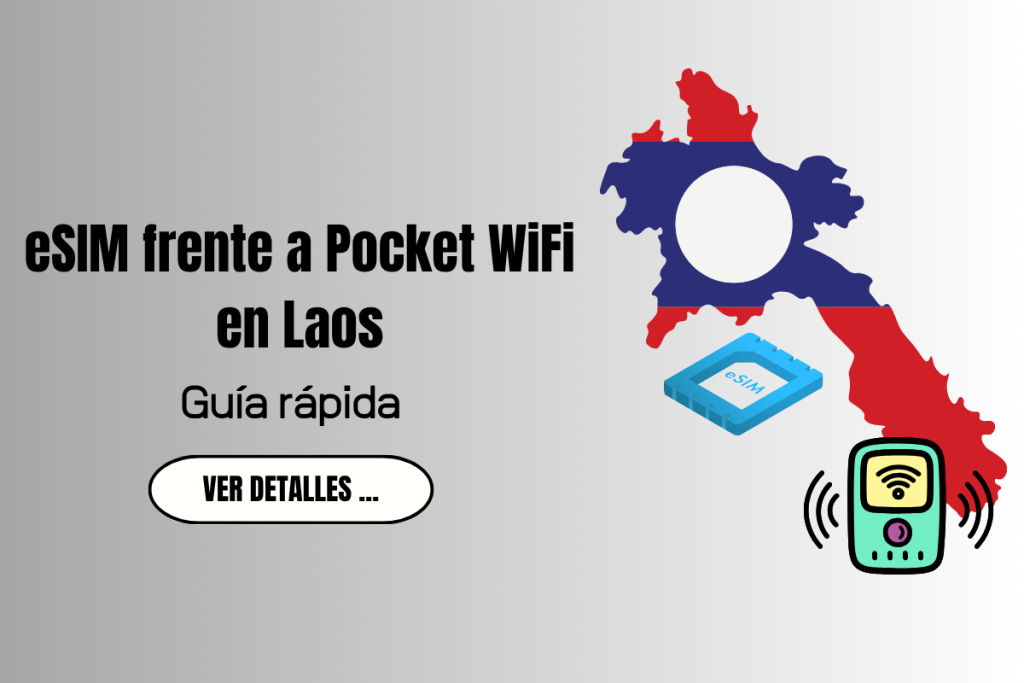Laos, with its stunning landscapes and rich cultural heritage, has become an increasingly popular destination for travelers. While exploring ancient temples and navigating night markets, staying connected is essential for everything from finding directions to translating menus. Two main technologies dominate the travel connectivity landscape: eSIMs and Pocket WiFi. This guide will help you understand which option best suits your Laos adventure.

I. What Is eSIM and What Is Pocket WiFi?
When traveling abroad, you have two main options for staying connected: eSIMs and Pocket WiFi. Each serves different needs and travel styles.
What is an eSIM?
An eSIM (embedded SIM) represents the evolution of traditional SIM cards, offering a completely digital solution built directly into your device. Unlike physical cards, eSIMs are permanently embedded in compatible smartphones and tablets.
Setting up an eSIM typically involves scanning a QR code provided by your service provider, after which your device connects to local networks in Laos. Most newer smartphones support eSIM technology, including iPhone XS or newer models, Google Pixel 3 and later, and many Samsung Galaxy devices released after 2020.
What is Pocket WiFi?
A Pocket WiFi is a portable internet hotspot that creates a WiFi network wherever you go:
- Connects multiple devices – Phones, laptops, and tablets can all connect simultaneously
- Requires maintenance – Needs daily charging and carrying
This option works best for families or groups traveling together who need to share internet across several devices.
Your choice depends on your travel group size, number of devices, and convenience preferences.
II. Availability of eSIM and Pocket WiFi in Laos
eSIMs have become widely available through global providers like LaoseSIM, Airalo, and Gigago, allowing you to purchase and download a plan before even arriving in Laos. Local carriers including Unitel, Lao Telecom, and TPlus also offer eSIM options, though these generally require in-person activation after arrival.
Pocket WiFi has more limited availability in Laos. While not typically available for immediate rental at airports, several online services allow you to book in advance with pickup locations in major cities like Vientiane and Luang Prabang. Some international rental services also offer delivery to your hotel.
III. Comparison Table: eSIM vs. Pocket WiFi in Laos
When deciding between these technologies for your Laos trip, several factors come into play:
| Feature | eSIM | Pocket WiFi |
| Setup Process | Digital activation, can be done before arrival | Requires physical pickup and return |
| Device Compatibility | Only works with eSIM-enabled phones | Works with any WiFi-capable device |
| Multiple Users | One device per eSIM | Connects 5-10 devices simultaneously |
| Network Coverage | Local Lao networks (Unitel, Lao Telecom) | Same local networks |
| Battery Management | Uses your phone’s battery | Requires separate charging (6-8 hour battery life) |
IV. Which One Should You Choose?
Your ideal connectivity solution depends largely on your specific travel circumstances:
- eSIM is likely your best choice if you’re traveling solo or as a couple with newer smartphones. The convenience of digital setup, combined with the lack of additional devices to carry and charge, makes eSIMs particularly attractive for independent travelers seeking simplicity.
- Pocket WiFi makes more sense when you’re traveling with family or in a group where multiple people need internet access. It’s also preferable if you need to connect non-cellular devices like laptops, or if your smartphone doesn’t support eSIM technology.
V. Cost Comparison in Laos
For a typical trip to Laos in 2025, eSIM plans from LaoseSIM offer competitive pricing:
- 5 Days/10GB: $5.50
- 10 Days/15GB: $6.90
- 15 Days/30GB: $12.90
- Multi-country options (including Laos, Vietnam, Cambodia): $16.50-$94.50 depending on duration
Pocket WiFi rentals typically cost $5-10 per day plus a refundable deposit of $50-100, making them more expensive for individual users but potentially cost-effective when shared among multiple travelers.
VI. FAQs
Can I buy an eSIM before arriving in Laos?
Yes, you can purchase and activate an eSIM for Laos before your trip through online providers like LaoseSIM. The process typically involves purchasing online, receiving a QR code via email, and scanning it with your phone, allowing you to be connected immediately upon landing in Laos.
Can I use eSIM for hotspot?
Yes, you can use your eSIM data plan to create a mobile hotspot if your phone supports tethering functionality. This allows you to share your connection with other devices like laptops or tablets, though be aware that hotspot usage will consume your data more quickly and drain your phone’s battery faster.
What’s better for a 1-week trip?
For a one-week trip to Laos, an eSIM is generally the better option as it’s more cost-effective (around $6-7 for 10-15GB), requires no physical pickup or return, and eliminates the need to carry an extra device. LaoseSIM’s 10-day plan with 15GB for $6.90 offers excellent value for a week-long visit.